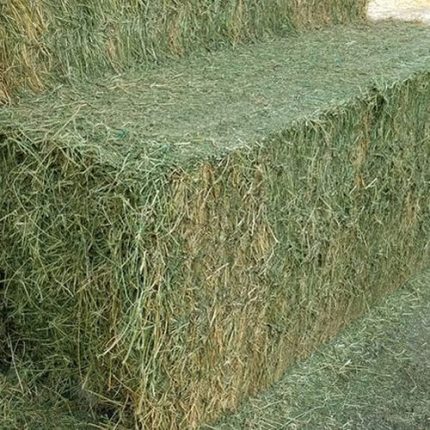Rhodes Grass Hay
Rhodes grass (Chloris gayana) is a summer-growing, stoloniferous perennial, whose runners provide good soil cover for erosion control. Rhodes grass is adapted to a wide range of soils, from infertile sands to fertile brigalow clays. It is difficult to establish and have it persist on heavy-cracking clay soils.
Rhodes grass does not tolerate drought or flooding well and is best adapted to areas where annual rainfall exceeds 600 mm. It is only moderately tolerant of frost, but tolerant of salinity and cool burning. Low oxalate concentrations make Rhodes grass a valuable pasture grass for horses.
Varieties
Pioneer, also known as commercial Rhodes grass, is an early-flowering, erect plant with moderate leafiness. Because it will run to flower quickly throughout the growing season, its feed quality drops quickly. Pioneer has been superseded by Katambora.
Katambora is later flowering than Pioneer, so remains more leafy and productive into autumn. It is also finer leaved and more stoloniferous.
Callide is later flowering than Katambora, is less cold-tolerant and needs a higher rainfall than Pioneer or Katambora. Callide is more palatable and can be more productive than Pioneer or Katambora under conditions of higher fertility.
Finecut is a variety that has been selected for its improved grazing qualities. It has fine leaves and stems, is early flowering, of uniform maturity and high yielding. Finecut was derived from Katambora.
Topcut, developed from Pioneer, has been selected for improved haymaking qualities. It has fine leaves and stems, is early flowering, of uniform maturity and is high yielding.
Home Plants Field crops and pastures Pastures Rhodes grass
Pastures
Establishing sown pastures
Purple pigeon grass
Pastures for horses on the Darling Downs
Perennial pastures for the Darling Downs
Saltbush
Bambatsi
Floren bluegrass
Subterranean clover for granite and traprock soils
Serradella
Indian bluegrass
Pastures for high rainfall granite country (south east Darling Downs)
Rhodes grass
Enhancing post-drought recovery
Enhancing native pastures
Pasture for traprock, sandstone and dry granite country
Buffel grass in south Queensland
Grazing land management
Desmanthus
Green panic
Digit grass
Annual medics
Vetches in southern Queensland
Creeping bluegrass
Related products
Alfalfa Hay
Bermuda hay
Oat Hay
| Bale size Lenght, Width, Height | Container weight | Bale Weight | No bales in 40 HQ | FOB Valencia Port €/MT | ||||
| Dehydratred Alfalfa | 65 cm x 40 cm x, 35 cm | 22 MT app | 37 kg app | 600 app | 315.00 | |||
| Sun dried Alfalfa | 65 cm x 40 cm x, 35 cm | 22 MT app | 37 kg app | 600 app | 295.00 | |||
| Ray-grass | 65 cm x 40 cm x 35 cm | 20 MT app | 34 kg app | 600 app | 285.00 | |||
| Oaten hay | 70 cm x 40 cm x 35 cm | 19 MT app | 32 kg app | 570 app | 235.00 | |||
| Straw hay | 70 cm x 40 cm x 35 cm | 17 MT app | 30 kg app | 570 app | 155.00 |










Reviews
There are no reviews yet.